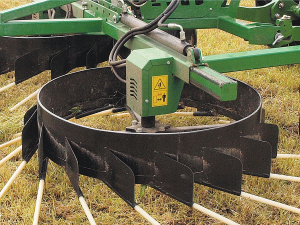Brent Raikes has moved on from the family business 4AG and has set up Ground Gear, supplying French-made Forges de Niaux disc blades through autumn and winter and Finnish-made Agronic front-mounted windrowers during spring and summer.
4AG was the NZ distributor of Forges de Niaux discs, so to focus more on the blades and to launch Ground Gear, Raikes has bought 4AG’s stock of Niaux discs and will distribute them.
“We still stay close to 4AG as they sell a lot of disc machines. Given the volume they sell and refurbish they are a good customer,” said Raikes
Agronic’s innovative front-mounted windrowers are said to have turned all knowledge of rotary windrowers on its head with a concept that is deceptively simple.
Offered as two models (WR 500 and WR 600), the windrowers are front-mounted and use two swathing rotors to merge two mower-conditioned rows into one. The single swath passes underneath the tractor for harvesting by a baler or self-loading wagon.
Raikes says Agronic machines are ideal for contractors because they can remove a tractor and labour unit out of the silage or hay-making operation, being no more obtrusive than a front mower, easy to set up and simple to operate.
Agronic also manufactures a wider trailing windrower with a hydraulically adjustable working width of 8.2 - 9.55m that should appeal to operators looking for a high-capacity windrower to run ahead of balers, loader wagons and choppers in a range of crop types.
The machine has a box section centre frame that carries a pair of hydraulically adjusted, sliding rotor sleeves beneath.
Each rotor is driven by its own hydraulic motor. Minimum required tractor oil flow would be about 40L/minute.
The rotor fingers are made of nylon/polyamide plastic rods with baffle plates fitted at the rear to help transfer crop to the centre of the windrower.
In operation, the rotor speed is adjusted to match the forward speed which is typically 8 - 12 km/h depending on conditions or crop -- much faster than traditional twin rotor, steel tine configurations.
Working height is easily adjustable via triple support wheels.
















